Acanthus mollis Formulations for Transdermal Delivery: From Hydrogels to Emulsions
Abstract
:1. Introduction
2. Results and Discussion
2.1. Pre-Screen Solubility Studies
2.2. ATR-FTIR Measurements
2.3. Texture Analysis of Carbopol Formulations
2.4. In Vitro Drug Release Studies
2.5. Microscopic Analysis
3. Conclusions
4. Materials and Methods
4.1. Materials
4.2. Ethanol Extract
4.3. Solubility Studies
4.4. Preparation of Ethanolic Extract Topical Gels and Emulsions
4.5. Texture Profile Analysis (TPA)
4.6. Physicochemical Evaluation of Prepared EEt Gels
4.6.1. Attenuated Total Reflectance Fourier Transform Infrared
4.6.2. Transmission Electron Microscopy (TEM)
4.6.3. In Vitro Release Studies
- is the amount of drug released at time ;
- is the initial amount of drug in the formulation;
- is the zero-order/first-order/Higuchi release rate constant;
- is the base of the natural logarithm;
- is the total time of drug release;
- is a constant incorporating factors such as the structural and geometric characteristics of the drug delivery system;
- is the release exponent characterizing the release mechanism;
- is the total amount of drug to be released;
- is the scale parameter;
- is the shape parameter;
- and denote the cumulative amounts of drug released at time and infinity, respectively;
- is the diffusion rate constant.
Author Contributions
Funding
Institutional Review Board Statement
Informed Consent Statement
Data Availability Statement
Acknowledgments
Conflicts of Interest
References
- Fiorini-Puybaret, C. Cosmetic Composition Including an Acanthus Extract, and Use of Acanthus in a Cosmetic Hair-Care Composition. U.S. Patent Application No. 13/138,054, 3 November 2011. pp. 1–5. [Google Scholar]
- Rivera, D.; Obón, C. The ethnopharmacology of Madeira and Porto Santo Islands, a review. J. Ethnopharmacol. 1995, 46, 73–93. [Google Scholar] [CrossRef] [PubMed]
- Freitas, F.; Mateus, M. Plantas e Seus Usos Tradicionais; Serviço do Parque Natural da Madeira: Funchal, Portugal, 2013; p. 86. [Google Scholar]
- Ferrão, J.; Liberato, M. Dicionário de Plantas Medicinais. Available online: http://icm.fch.lisboa.ucp.pt/resources/Documentos/CEPCEP/Dicionario,%20Letra%20A.pdf (accessed on 26 November 2023).
- Bader, A.; Martini, F.; Schinella, G.R.; Rios, J.L.; Prieto, J.M. Modulation of Cox-1, 5-, 12- and 15-Lox by popular herbal remedies used in Southern Italy against psoriasis and other skin diseases. Phytother. Res. 2015, 29, 108–113. [Google Scholar] [CrossRef] [PubMed]
- Matos, P.; Figueirinha, A.; Paranhos, A.; Nunes, F.; Cruz, P.; Geraldes, C.; Cruz, M.T.; Batista, M.T. Bioactivity of Acanthus mollis—Contribution of benzoxazinoids and phenylpropanoids. J. Ethnopharmacol. 2018, 227, 198–205. [Google Scholar] [CrossRef] [PubMed]
- Matos, P.; Figueirinha, A.; Ferreira, I.; Cruz, M.T.; Batista, M.T. Acanthus mollis L. leaves as source of anti-inflammatory and antioxidant phytoconstituents. Nat. Prod. Res. 2019, 33, 1824–1827. [Google Scholar] [CrossRef] [PubMed]
- Matos, P.; Paranhos, A.; Batista, M.T.; Figueirinha, A. Synergistic effect of DIBOA and verbascoside from Acanthus mollis leaf on tyrosinase inhibition. Int. J. Mol. Sci. 2022, 23, 13536. [Google Scholar] [CrossRef] [PubMed]
- Kamo, H.; Kawahara, R.; Simizu, S. Tyrosinase suppresses vasculogenic mimicry in human melanoma cells. Oncol. Lett. 2022, 23, 169. [Google Scholar] [CrossRef] [PubMed]
- Pham, T.-N.; Cazier, E.A.; Gormally, E.; Lawrence, P. Valorization of biomass polyphenols as potential tyrosinase inhibitors. Drug Discov. Today 2023, 29, 103843. [Google Scholar] [CrossRef]
- Karamkar, P.G.; Agrawal, A.; Chatap, V.K. A review article: Formulation of topical gel by QbD approach. Adv. Pharmacol. Pharm. 2023, 11, 90–101. [Google Scholar] [CrossRef]
- Chang, R.-K.; Raw, A.; Lionberger, R.; Yu, L. Generic development of topical dermatologic products: Formulation development, process development, and testing of topical dermatologic products. AAPS J. 2013, 15, 41–52. [Google Scholar] [CrossRef]
- Herbig, M.E.; Evers, D.-H.; Gorissen, S.; Köllmer, M. Rational design of topical semi-solid dosage forms-how far are we? Pharmaceutics 2023, 15, 1822. [Google Scholar] [CrossRef]
- Almoshari, Y. Novel hydrogels for topical applications: An updated comprehensive review based on source. Gels 2022, 8, 174. [Google Scholar] [CrossRef] [PubMed]
- Jaquilin, P.J.R.; Oluwafemi, O.S.; Thomas, S.; Oyedeji, A.O. Recent advances in drug delivery nanocarriers incorporated in temperature-sensitive Pluronic F-127–A critical review. J. Drug Deliv. Sci. Technol. 2022, 72, 103390. [Google Scholar] [CrossRef]
- Jaworski, Z.; Spychaj, T.; Story, A.; Story, G. Carbomer microgels as model yield-stress fluids. Rev. Chem. Eng. 2022, 38, 881–919. [Google Scholar] [CrossRef]
- Generally Recognized as Safe (GRAS) | FDA. Available online: https://www.fda.gov/food/food-ingredients-packaging/generally-recognized-safe-gras (accessed on 23 November 2023).
- Council of Europe. European Pharmacopoeia, 11th ed.; Council of Europe: Strasbourg, France, 2023. [Google Scholar]
- Su, Y.; Wang, J.; Liu, H. FTIR spectroscopic investigation of effects of temperature and concentration on PEO−PPO−PEO block copolymer properties in aqueous solutions. Macromolecules 2002, 35, 6426–6431. [Google Scholar] [CrossRef]
- Su, Y.; Wang, J.; Liu, H. Melt, hydration, and micellization of the PEO–PPO–PEO block copolymer studied by FTIR spectroscopy. J. Colloid. Interface Sci. 2002, 251, 417–423. [Google Scholar] [CrossRef] [PubMed]
- Branca, C.; Khouzami, K.; Wanderlingh, U.; D’Angelo, G. Effect of intercalated Chitosan/Clay nanostructures on concentrated Pluronic F127 solution: A FTIR-ATR, DSC and rheological study. J. Colloid. Interface Sci. 2018, 517, 221–229. [Google Scholar] [CrossRef] [PubMed]
- Özden, S.; Özden, T.; Attila, I.; Küçükislamoglu, M.; Okatan, A. Isolation and identification via High-Performance Liquid Chromatography and Thin-Layer Chromatography of benzoxazolinone precursors from Consolida orientalis flowers. J. Chromatogr. A 1992, 609, 402–406. [Google Scholar] [CrossRef]
- Peleg, M. The instrumental texture profile analysis revisited. J. Texture Stud. 2019, 50, 362–368. [Google Scholar] [CrossRef]
- Vadnere, M.; Amidon, G.; Lindenbaum, S.; Haslam, J.L. Thermodynamic studies on the Gel-Sol transition of some Pluronic polyols. Int. J. Pharm. 1984, 22, 207–218. [Google Scholar] [CrossRef]
- Klouda, L.; Mikos, A.G. Thermoresponsive hydrogels in biomedical applications. Eur. J. Pharm. Biopharm. 2008, 68, 34–45. [Google Scholar] [CrossRef]
- Dumortier, G.; Grossiord, J.L.; Agnely, F.; Chaumeil, J.C. A review of Poloxamer 407 pharmaceutical and pharmacological characteristics. Pharm. Res. 2006, 23, 2709–2728. [Google Scholar] [CrossRef] [PubMed]
- Bruschi, M. Mathematical models of drug release. In Strategies to Modify the Drug Release from Pharmaceutical Systems, 1st ed.; Elsevier—Woodhead Publishing: Cambridge, UK, 2015; pp. 63–86. [Google Scholar]
- Costa, P.; Sousa Lobo, J.M. Modeling and comparison of dissolution profiles. Eur. J. Pharm. Sci. 2001, 13, 123–133. [Google Scholar] [CrossRef] [PubMed]
- Holowka, E.P.; Bhatia, S.K. Controlled-release systems. In Drug Delivery; Springer: New York, NY, USA, 2014; pp. 7–62. [Google Scholar]
- Mircioiu, C.; Voicu, V.; Anuta, V.; Tudose, A.; Celia, C.; Paolino, D.; Fresta, M.; Sandulovici, R.; Mircioiu, I. Mathematical modeling of release kinetics from supramolecular drug delivery systems. Pharmaceutics 2019, 11, 140. [Google Scholar] [CrossRef] [PubMed]
- Paarakh, M.P.; Jose, P.A.; Setty, C.; Peterchristoper, G.V. Release kinetics—Concepts and applications. Int. J. Pharm. Res. Technol. 2019, 8, 12–20. [Google Scholar]
- Talevi, A.; Ruiz, M.E. Korsmeyer-Peppas, Peppas-Sahlin, and Brazel-Peppas: Models of drug release. In The ADME Encyclopedia; Springer International Publishing: Cham, Germany, 2022; pp. 613–621. [Google Scholar]
- Papadopoulou, V.; Kosmidis, K.; Vlachou, M.; Macheras, P. On the use of the weibull function for the discernment of drug release mechanisms. Int. J. Pharm. 2006, 309, 44–50. [Google Scholar] [CrossRef]
- Talevi, A.; Ruiz, M.E. Baker-Lonsdale model of drug release. In The ADME Encyclopedia; Springer International Publishing: Cham, Germany, 2022; pp. 95–101. [Google Scholar]
- Negut, I.; Bita, B. Polymeric micellar systems—A special emphasis on “smart” drug delivery. Pharmaceutics 2023, 15, 976. [Google Scholar] [CrossRef]
- Ghezzi, M.; Pescina, S.; Padula, C.; Santi, P.; Del Favero, E.; Cantù, L.; Nicoli, S. Polymeric micelles in drug delivery: An insight of the techniques for their characterization and assessment in biorelevant conditions. J. Control. Release 2021, 332, 312–336. [Google Scholar] [CrossRef]

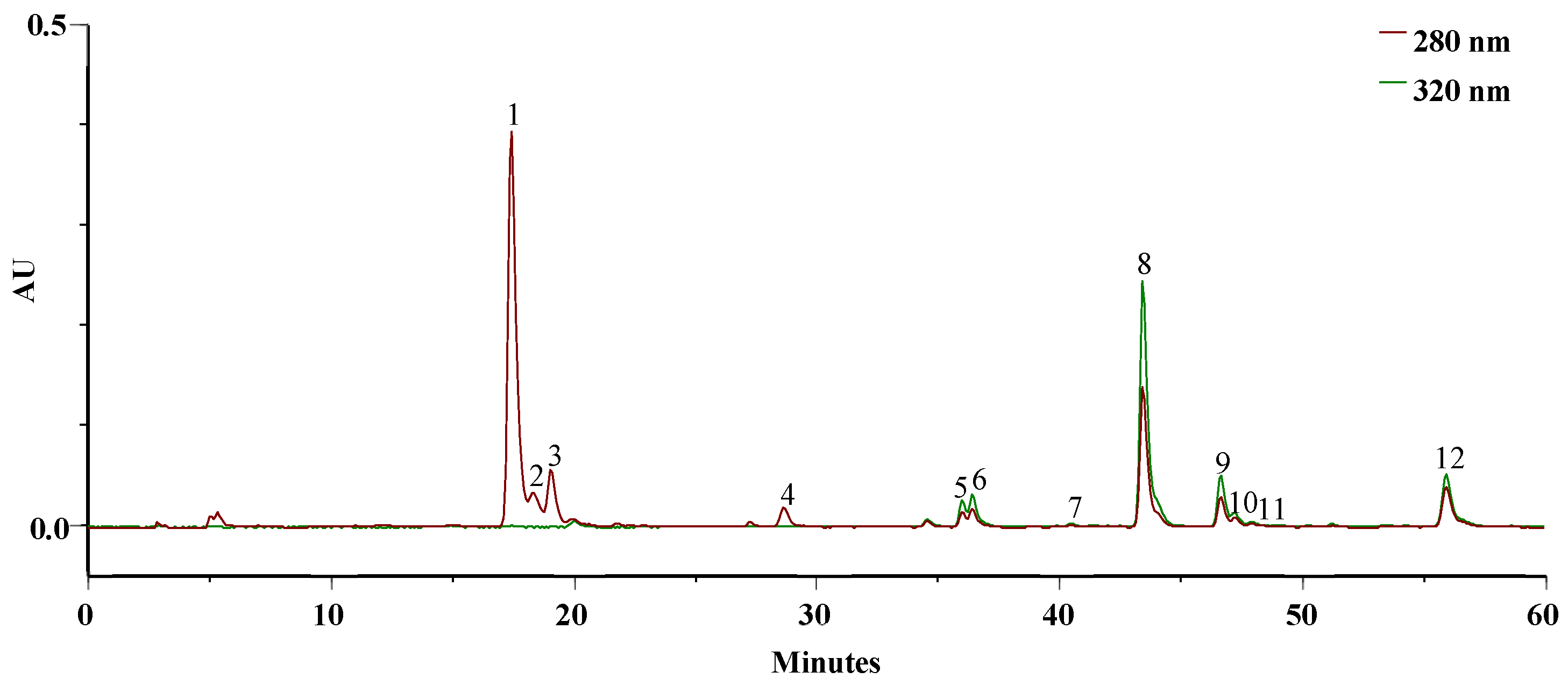

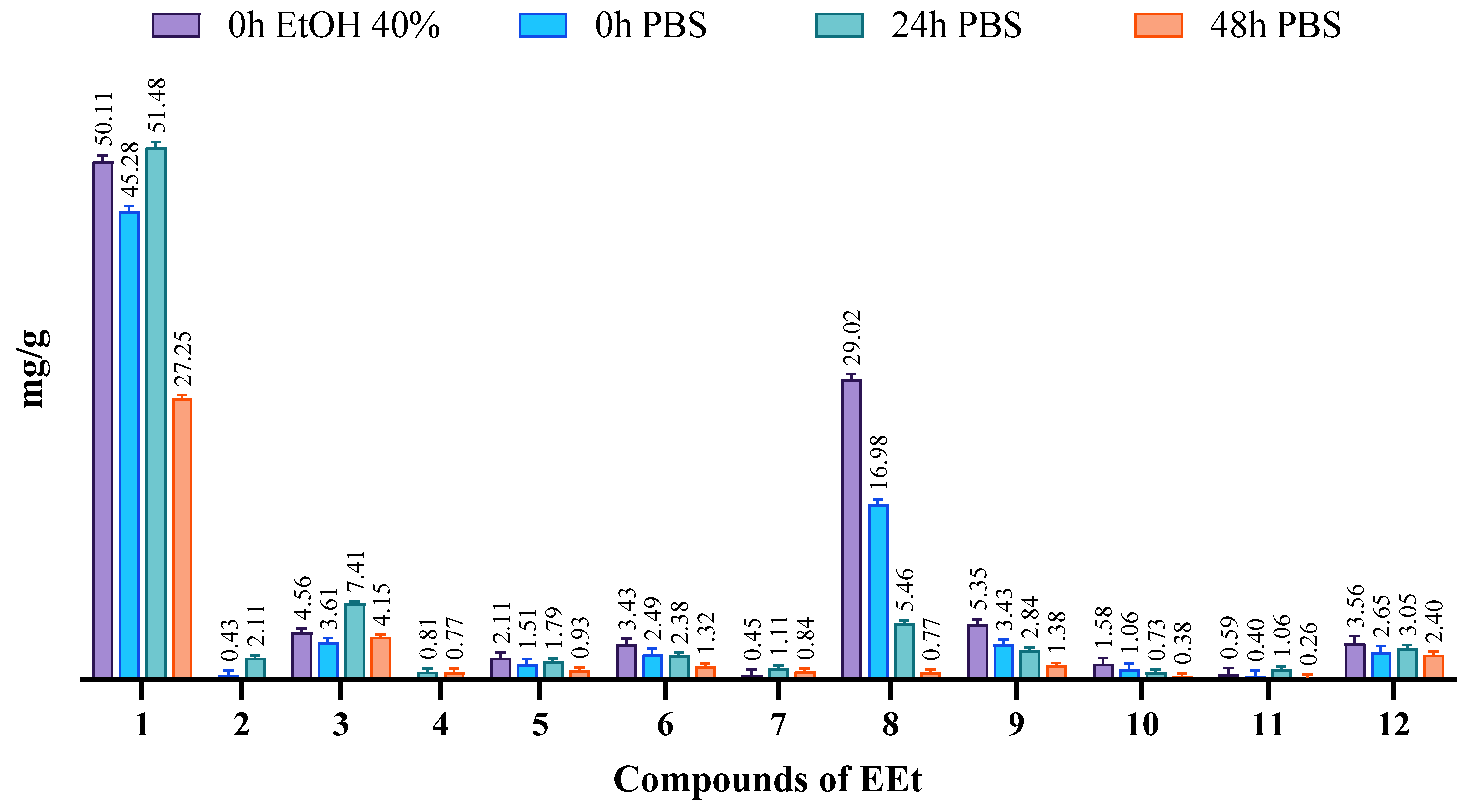
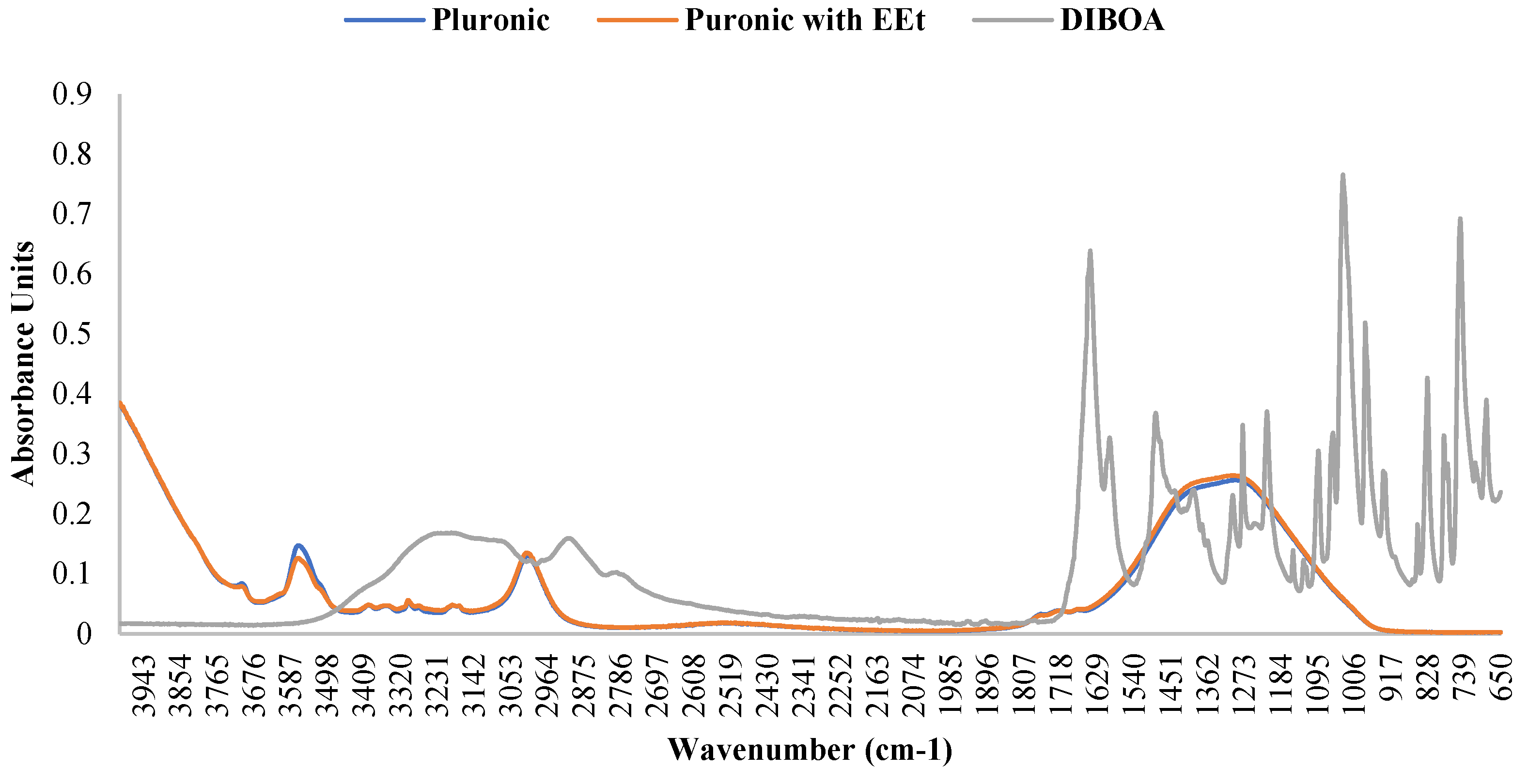
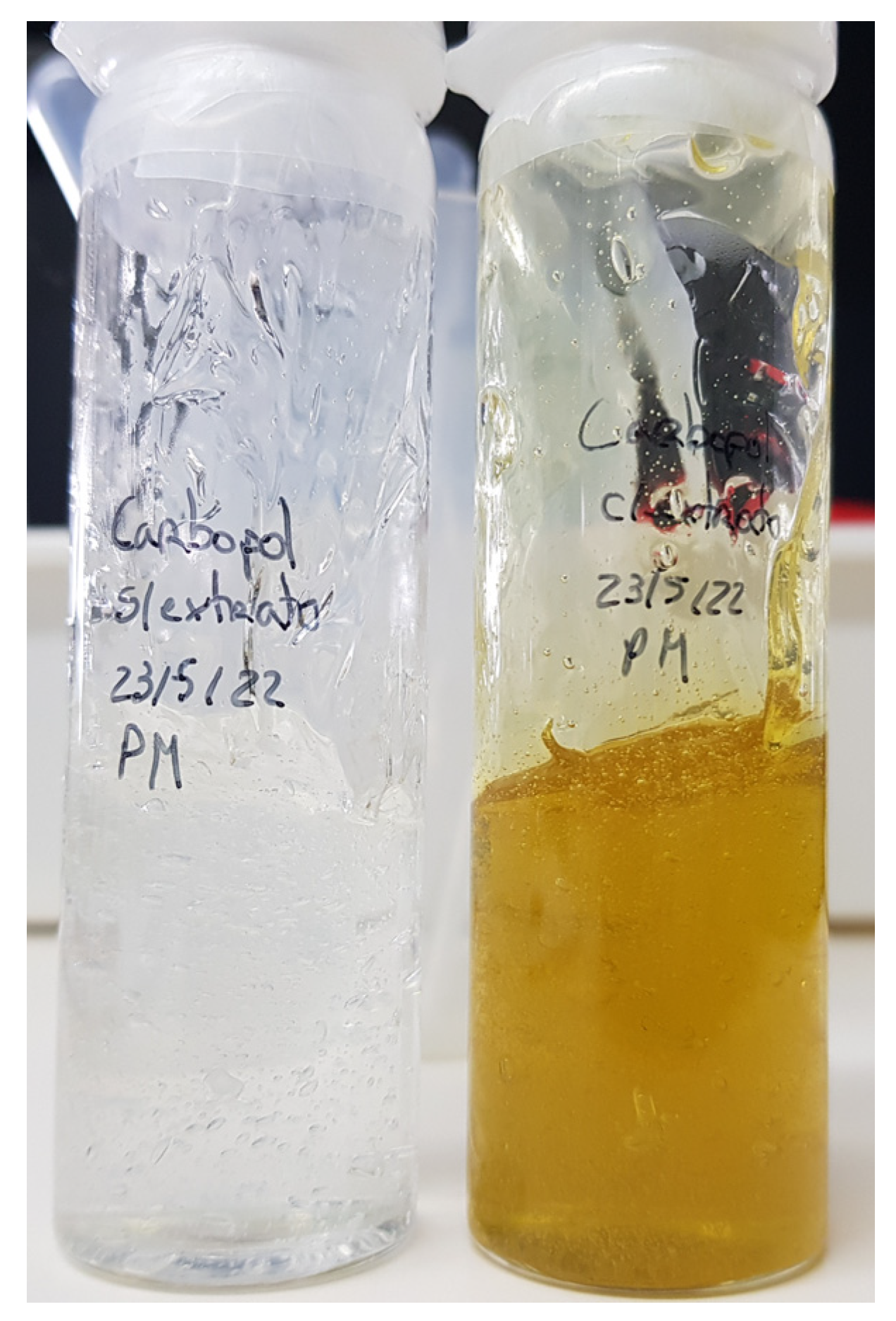
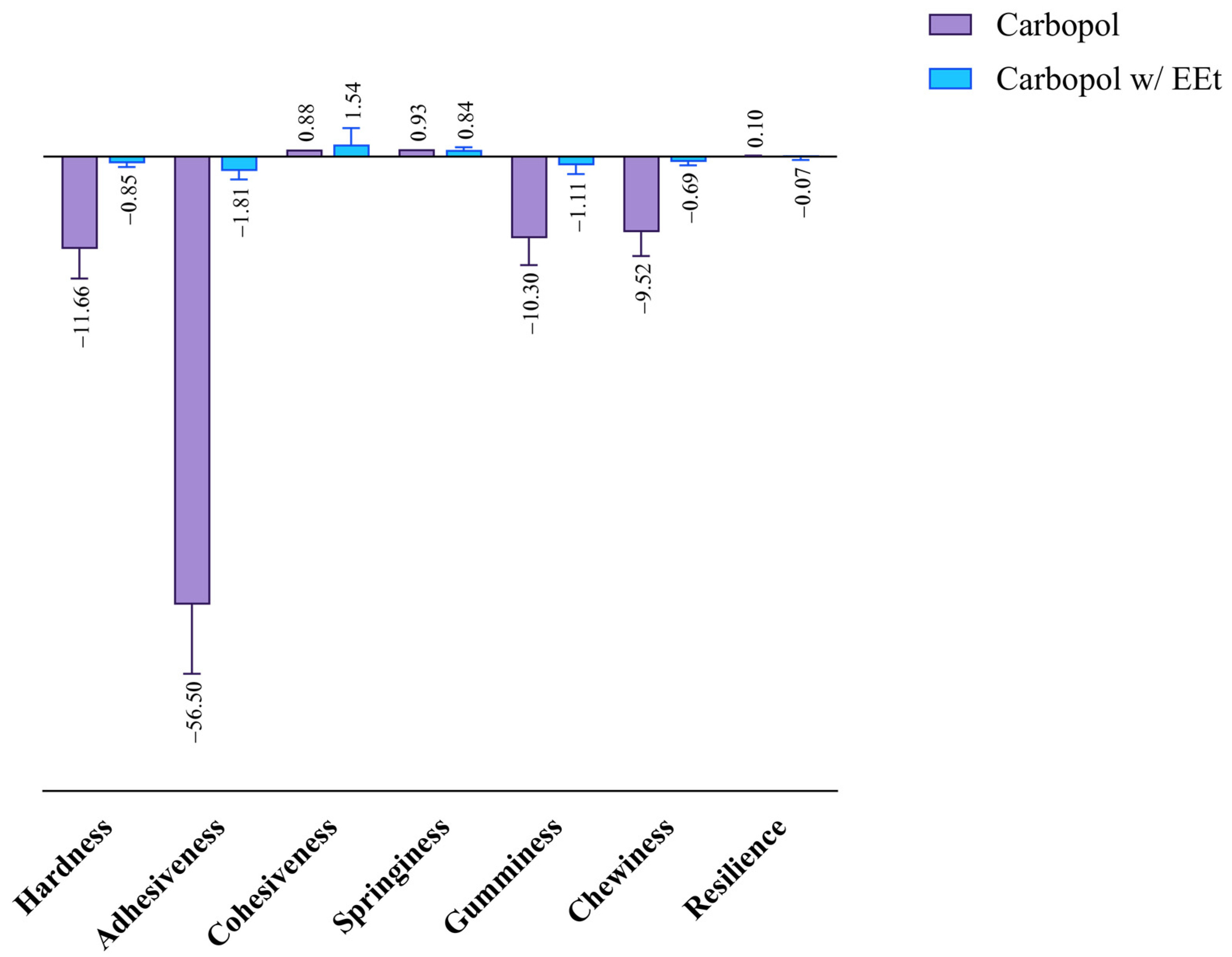

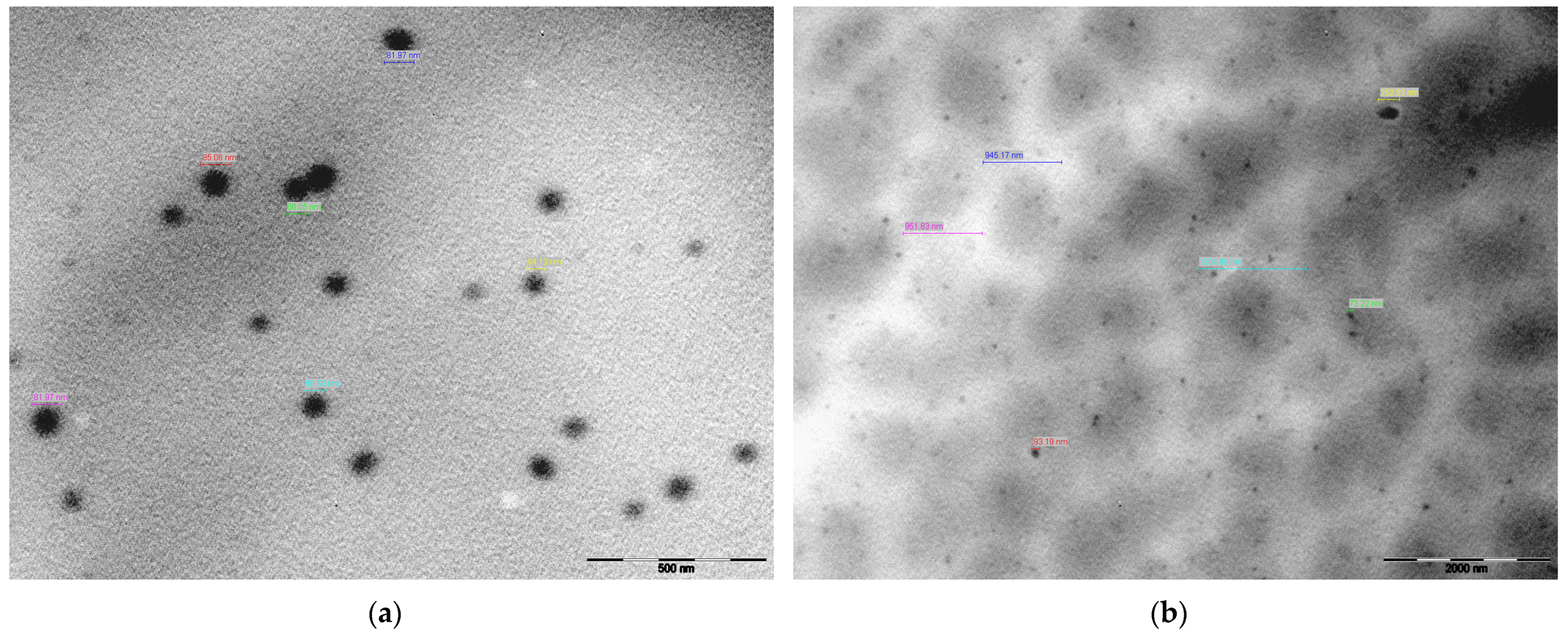

| Model | r2 | SD | K (µg/h) | SD | Formulation |
|---|---|---|---|---|---|
| Zero order | 0.4864 | 0.0270 | 0.6276 | 0.0000 | Carbopol |
| 0.6839 | 0.1963 | 1.0393 | 0.0000 | Pluronic | |
| 0.9642 | 0.0027 | 1.0103 | 0.0000 | O/W | |
| First order | 0.8875 | 0.0808 | 0.0910 | 0.0111 | Carbopol |
| 0.5868 | 0.1684 | 0.1147 | 0.0313 | Pluronic | |
| 0.9320 | 0.1018 | 0.0361 | 0.0007 | O/W | |
| Higuchi | 0.7323 | 0.0302 | 1.6448 | 0.0517 | Carbopol |
| 0.8869 | 0.0795 | 4.1211 | 1.5800 | Pluronic | |
| 0.8362 | 0.0573 | 9.5701 | 0.6970 | O/W | |
| Hixson–Crowell | 0.9193 | 0.0610 | 0.0001 | 0.0000 | Carbopol |
| 0.6956 | 0.2104 | 0.0003 | −0.0002 | Pluronic | |
| 0.9639 | 0.0023 | 0.0003 | 0.0000 | O/W | |
| Korsmeyer–Peppas | 0.7347 | 0.2225 | 1.5621 | 0.7230 | Carbopol |
| 0.8203 | 0.1325 | 2.5891 | 1.1037 | Pluronic | |
| 0.9087 | 0.0384 | 4.5412 | 0.3306 | O/W | |
| Weibull | 0.9615 | 0.0081 | 0.1317 | 0.0182 | Carbopol |
| 0.9383 | 0.0285 | 0.4267 | 0.0508 | Pluronic | |
| 0.6774 | 0.0297 | 0.5144 | 0.0398 | O/W | |
| Baker–Lonsdale | 0.7231 | 0.0240 | 0.0000 | 0.0000 | Carbopol |
| 0.7694 | 0.1771 | 0.0000 | 0.0000 | Pluronic | |
| 0.9547 | 0.0250 | 0.0000 | 0.0000 | O/W |
| Ingredients | Carbopol | Pluronic 22% | Emulsion O/W |
|---|---|---|---|
| EEt | 0.50 g | 0.67 g | 1.23 g |
| Carbopol® 940 | 0.15 g | --- | --- |
| Triethanolamine | Enough to reach pH = 6.5 and 8.3 | --- | 0.6 g |
| Pluronic F-127 | 6.6 g | --- | |
| Stearic acid | --- | --- | 12 g |
| Glycerin | --- | --- | 6.75 g |
| Methylparaben | --- | --- | 0.05 g |
| Purified water | 30 g | 30 g | 50 g |
Disclaimer/Publisher’s Note: The statements, opinions and data contained in all publications are solely those of the individual author(s) and contributor(s) and not of MDPI and/or the editor(s). MDPI and/or the editor(s) disclaim responsibility for any injury to people or property resulting from any ideas, methods, instructions or products referred to in the content. |
© 2023 by the authors. Licensee MDPI, Basel, Switzerland. This article is an open access article distributed under the terms and conditions of the Creative Commons Attribution (CC BY) license (https://creativecommons.org/licenses/by/4.0/).
Share and Cite
Matos, P.; Batista, M.T.; Veiga, F.; Figueirinha, A.; Figueiras, A. Acanthus mollis Formulations for Transdermal Delivery: From Hydrogels to Emulsions. Gels 2024, 10, 36. https://doi.org/10.3390/gels10010036
Matos P, Batista MT, Veiga F, Figueirinha A, Figueiras A. Acanthus mollis Formulations for Transdermal Delivery: From Hydrogels to Emulsions. Gels. 2024; 10(1):36. https://doi.org/10.3390/gels10010036
Chicago/Turabian StyleMatos, Patrícia, Maria Teresa Batista, Francisco Veiga, Artur Figueirinha, and Ana Figueiras. 2024. "Acanthus mollis Formulations for Transdermal Delivery: From Hydrogels to Emulsions" Gels 10, no. 1: 36. https://doi.org/10.3390/gels10010036
APA StyleMatos, P., Batista, M. T., Veiga, F., Figueirinha, A., & Figueiras, A. (2024). Acanthus mollis Formulations for Transdermal Delivery: From Hydrogels to Emulsions. Gels, 10(1), 36. https://doi.org/10.3390/gels10010036







